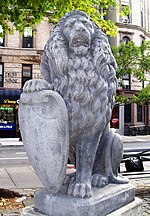Hebrew Technical Institute (New York City)

Hebrew Technical Institute was a vocational High School in New York City. The school was founded on January 7, 1884 and closed in 1939.After completing two years at the school, students could specialize in wood-working, pattern making, metal working, instrument making, mechanical drawing, architectural drawing, wood carving, free-hand drawing or applied electricity. The school was founded after three Hebrew charity organizations formed a committee to promote technical education for the many Jewish immigrants arriving in New York at the time. The school originally opened at 206 East Broadway. After a number of relocations, the school moved into 34 and 36 Stuyvesant Street.
Excerpt from the Wikipedia article Hebrew Technical Institute (New York City) (License: CC BY-SA 3.0, Authors, Images).Hebrew Technical Institute (New York City)
East 9th Street, New York Manhattan
Geographical coordinates (GPS) Address Nearby Places Show on map
Geographical coordinates (GPS)
| Latitude | Longitude |
|---|---|
| N 40.729803 ° | E -73.98797 ° |
Address
Barney Building
East 9th Street 227
10003 New York, Manhattan
New York, United States
Open on Google Maps





